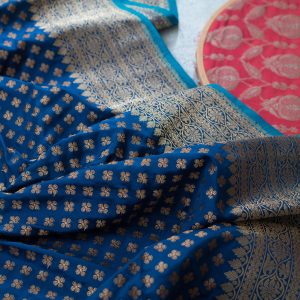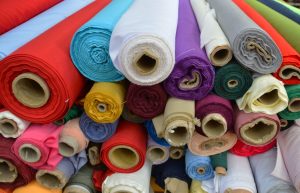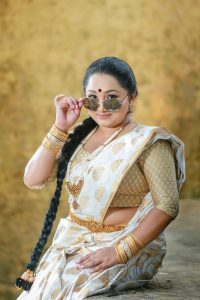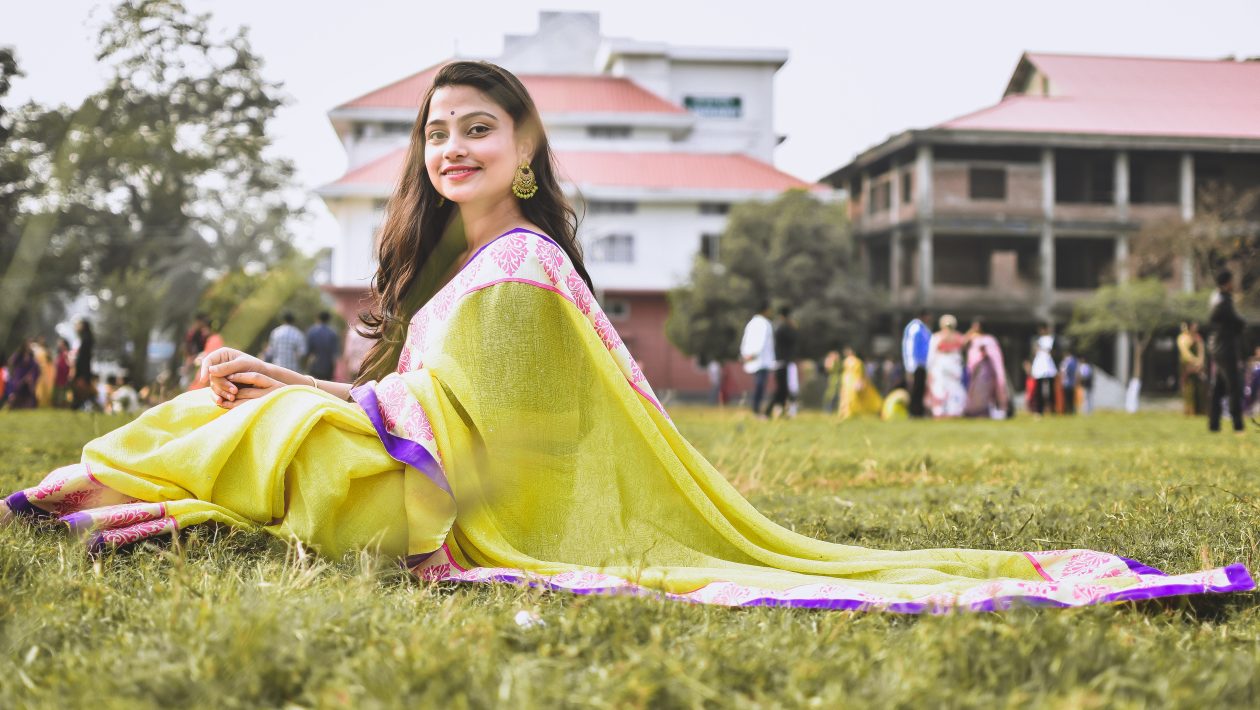Saree, the indispensable attire of the culturally diverse India, is the definition of elegance, allure, and beauty. This sophisticated garment brings out the culture and tradition of various Indian states. So, here’s an A to Z saree name list that includes the absolute classics from different parts of the country.
Every region in India has its unique sarees that exude grace. Not just Indians, but western countries now take an interest in draping this unique attire to give try a desi look. Many brands now sell skirt sarees that require less time to wear and easy for people who are not used to draping. Before choosing a saree pattern, you need to go through the variety.
Table of Contents
A to Z saree name list
Derived from ‘shati’ (a Sanskrit word), saree stands for the 4-9 years of fabric elegantly draped around the waist of an Indian woman. No other dress can highlight your curves and give a flattering look to your figure like a saree. Luckily, each Indian state has its unique technique of weaving sarees that give them an exclusive avatar.
The A to Z saree name list will help you understand more about sarees and make the perfect choice for your first adornment:
Ashavali (Gujarat)
Hailing from Gujarat’s Ahmedabad, Ashavali sarees are all about weaving tales around flowers blooming and birds chirping. These nature-inspired designs enhance the aesthetic appeal of this saree. The borders stand out because of an enameled look and interwoven designs. The brocade pattern of Banarasi sarees is influenced by Ashavali popularized by the migration of Gujarati weavers to Varanasi.
Baluchari (West Bengal)
Baluchari is a silk saree crafted in West Bengal’s Bankura district. It owes its origin to Dhaka, Bangladesh, which once used to be a part of India. You will instantly recognize a Baluchari saree from its pallu which depicts scenes from the Mahabharata and Ramayana.
Swarnachari is a type of Baluchari saree which is weaved in zari. It takes one week to weave a Baluchari saree and it’s among the costliest sarees. That explains why in earlier times, only elite women wore Balucharis.
Banarasi (Uttar Pradesh)
Meticulously made of the finest silks, Banarasi sarees are known for their Brocade work of silver or gold zari. They are heavily engraved and form an integral part of the Bengali bridal attire. Vibrant in color, Balucharis have several varieties like Cutwork, Jangla, Butidar, and Tanchoi. They are named after Banaras, the sacred city situated on the bank of River Ganga.

Bomkai (Odisha)
Bomkai sarees, made in Odisha’s Bomkai village, are one of a kind. They feature lovely interwoven motifs of peacocks, lotus, fish, tortoise, and tribal art. The procedure followed by the skilled weavers to make the Bomkai saree pattern is called the Jala technique. While silk Bomkai is perfect for important occasions, cotton Bomkai is a regular wear.
Chanderi (Madhya Pradesh)
Chanderi is an artistic town in Madhya Pradesh where you’ll find the best Chanderi silk sarees. Made from fine cotton or pure silk, Chanderis have a glossy transparent and a sheer texture. They are so airy that you can wear them comfortably in the humid months. These gorgeous sarees borrow their designs from nature.
Chikankari (Uttar Pradesh)
Chikankari work belongs to the city of Nawabs, Lucknow. It is a rare form of embroidery that uses diverse types of stitches and threads. The fabric of a Chikan saree can be chiffon, georgette, muslin, or cotton. The texture of Chikankaree sarees is light and the colors are eye-soothing.
Dhaniakhali (West Bengal)
Among the various kinds of cotton sarees found in multiple regions in India, Dhaniakhali is one of the best. This cotton saree is from West Bengal and it has contrasting borders in black, red, orange, purple, etc. The saree has a broad border of 6 inches and zari or Moga stripes adorn it gloriously.
Dharmavaram (Andhra Pradesh)
Woven from delicate tussar silk, Dharmavaram sarees have striking similarities with Kanjeevaram sarees. However, their most remarkable feature is that they are woven in two colors. This gives them a radiant yet subdued dual-tone effect. The heavy-work pallus, butta designs, and golden zari make add to Dharmavaram’s grace.
Eri Silk
The harvest of Eri silk takes place in Japan, China, and the north-eastern state of Assam. It’s also called Ahims or non-violent silk as it involves extracting the silk without causing any harm to the silkworm. Eri silk sarees have exceptional durability which is suitable for rough use. The material is so weather-adaptive that it’ll keep you warm in winter and cool in summer.

Gadwal (Telangana)
Gadwal is a small town situated between Karnataka and Andhra. So, it takes inspiration from both the states to create a saree that’s mesmerizing. Its zari work stands out and the body is lightly designed with buttas. This saree is synonymous with simplicity.
Garad (West Bengal)
Korial or Garad are traditional sarees with laal paar. Bengali women wear it during Durga Puja and other religious celebrations.
The term ‘Garad’ stands for white and these sarees are not dyed. This preserves the purity of the fabric, thus making the saree sacredly important. They come in a white and red combination and the Garad textile industry is in Bengal’s Murshidabad.
Ilkal (Karnataka)
Ilkal is Karnataka’s most renowned saree that’s a combination of silk and cotton. The border and the pallu are of pure silk or art silk, while the wrap is of soft cotton. The process of making contemporary Ilkal drapes is a tedious one, locally termed the Topa Teni technique. The saree’s main body exhibits stripes, rectangular patterns, and squares.
Jamdani (West Bengal)
Jamdani sarees arise from an interesting combination of ancient Hindu culture and Mughal patronage. Extremely lightweight, the saree’s motifs float on the ultrafine fabric’s surface and have a mystical charm. Jamdani’s patterns are always subtle and the weavers borrow these ideas from real life. It is among the world’s most delicate muslin sarees.
Kalamkari (Andhra Pradesh)
The word Kalamkari is an amalgamation of two words: Kari (meaning creation) and Kalam (meaning pen). The fun part about these sarees is that tamarind twigs are necessary to sketch the motifs. The artists use only organic color obtained from vegetable dyes to add color to the fabric. The designs portray caves, old structures, and scenes from Hindu myths.
The art is so magical that it gets better with each wash. Women of all age groups love Kalamkari sarees for their astounding sturdiness, finesse, texture, and luster.
Kanjeevaram (Tamil Nadu)
Kanjeevaram is called the ‘Queen of Sarees’ and it comes from the Thiruvannamalai district of Tamil Nadu. Featuring a glossy temperament and royal texture, these sarees are the product of the utmost care and precision. The craftsmen use only Mulberry silk threads to weave this beauty.
Kanjeevaram sarees consist of motifs such as peacocks, jasmine buds, mangoes, swans, chariots, lions, moon, leaves, and coins. They come in luxurious shades and speak volumes about South India’s heritage and ethnicity.
Kantha Saree (West Bengal)
An A to Z saree name list is incomplete without including a range of sarees from West Bengal. For ages, Bengali women have relied on the Kantha stitch to recycle old and torn materials and design awe-inspiring quilts with them. Kantha sarees have a simple running stitch on their edges. There are elaborate versions that have the entire body covered with stitches along with pretty motifs.
Kasavu (Kerala)
When it comes to describing India’s most wonderful traditional sarees, how can one exclude Kerala’s sarees from this list? Kasavu is a cream-colored saree that has a plain cream body and a glossy golden border.
South Indian women prefer to wear this at Onam, weddings, and religious ceremonies. Because of its minimalist design, gifting this saree to your grandmother is a great idea.

Khun (Maharashtra and Karnataka)
Khun is one of the type of sarees with a 4000-year fascinating history. You will find this traditional weave in Maharashtra and Karnataka. The intricate brocade pattern adds to the beauty of the saree. The saree is airy and easy to maintain when you are at work or on a casual outing.
Kota Saree (Rajasthan)
Want a saree that’ll keep you cool in the summer months? Woven on a pit loom, the comfy Kota saree is all about its sheen, transparent body. Splendor and oomph are the trends of this saree which has thematic patterns. Zari embellishment on Kota sarees is also not uncommon.
Lehriya (Rajasthan)
When it comes to pleasing saree lovers, Rajasthan has a lot to offer. Mothura or Lehriya has a ‘leher’ (wavy) pattern, which is Rajasthan’s specialty. This saree is a multi-hued glory, a burst of bright hues.
Mangalgiri (Andhra Pradesh)
The handwoven Mangalgiri saree is quintessential for someone who loves to drape different types of saree. The kaleidoscopic effects and sensational shimmering of the saree will make you appear effortlessly flawless.
Muga (Assam)
Assam’s art and culture attract tourists from around the globe. Muga silk is an exclusive saree you will get only in Assam. The silk, sourced from wild silkworms, has a golden sheen and is durable. The manufacturers dye this saree using the bleaching technique. Its luster will be more prominent after a few washes.
Narayanpet (Telangana)
The widely popular Narayanpet is a fusion of Maratha and Telangana styles. This saree proves how the blending of diverse cultures creates an aesthetically fascinating garment. Its historic legacy is worth mentioning as Chatrapati Shivaji took an interest in these exquisite sarees. Narayanpet sarees come in earthly shades and are timeless classics.
Paithani (Maharashtra)
Does the beautiful Paithani silk saree remind you of Paithan in Maharashtra? It is another type of handwoven saree and its luxuriance will leave you spellbound. Forging a Paithani saree requires unparalleled skills which is evident in its intricate motifs.
Sambalpuri (Odisha)
A quiet village in Odisha, Sambalpur has become famous for its vibrant and traditional embroidered sarees. Sambalpuri sarees have soft cotton and tussar silk variations and they are the perfect workplace attire. These sarees infuse motifs like wheels, shells, temples, and flowers, and depict scenes from life in a coastal village.
Tant (West Bengal)
Tant is a saree originating in West Bengal, preferred by Bengali ladies for its transparency and lightness. This crisp cotton saree’s specialty lies in its stiffly starched fabric. The breathable material makes it an everyday attire that you can wear comfortably for hours in the summer season. It can also come with thick borders and beautiful prints to dazzle everyone on a special occasion.
Uppada (Andhra Pradesh)
Uppada is named after its place of origin Uppada, a picturesque beachside village in Andhra Pradesh’s Godavari district. Luxurious and translucent, Uppada sarees feature floral patterns, interesting motifs, and geometric designs.
Skilled craftsmen design these sarees using the ancient Jamdani method. They use Zari, gold, and silver threads to create a voguish look. The grandiose Uppada saree is handwoven and it has affluent work on the border and pallu.
Venkatgiri (Andhra Pradesh)
The classiest saree name list is incomplete without including Venkatgiri, the pride of Andhra Pradesh. The royal family of Nellore patronized Venkatgiri sarees and they are suitable for any climate. The natives of Ventatgiri, a historic town, handweave these sarees. The sarees are famous worldwide for their fineness, regal texture, softness, and durability.
Final thoughts
Did such an impressive variety of traditional sarees in stunning styles leave you mesmerized? Then why look for modern, Westernized saree inspirations when the Indian states have such extraordinary designs to offer?
Frequently Asked Questions
1. What are the different saree names?
Mysore silk, Bandhni, Chikan saree, Garad, Dhakai Jamdani, Kanjeevaram, Tant, and Kalamkari are some popular names you’ll find on an A to Z saree name list.
2. What is the name of a checked saree?
A Mangalgiri saree is a saree with a checked or striped pattern. These sarees are usually in the white shade, with black or blue stripes. A woman looks ethereal after wearing a Mangalgiri saree with gold jewelry.
3. What is the name of a traditional silk saree?
There are many traditional silk sarees and each stands out for its visual appeal and breathable fabric. Paithani silk saree, Kota saree, and Eri Silk sarees are some well-known ones.

